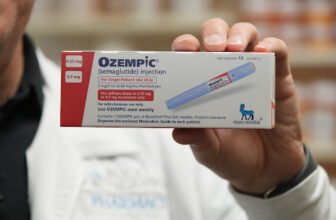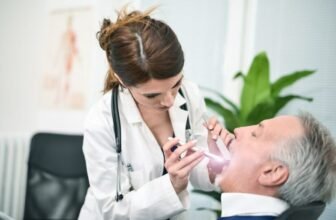
[adinserter block=”3″]
As told to Erica Rimlinger
I can’t remember a time when I didn’t have the fear. My mother was diagnosed with breast cancer when I was a senior in high school, and I was her caretaker until she passed away when I was 27.
My mom’s genetic tests showed she carried the BRCA gene, which I knew meant I might carry this genetic legacy too. But I delayed getting my own genetic test because I wanted to have more children. I wasn’t ready to have my breasts, uterus and ovaries removed if I carried the gene — and that would have been next.
Fortunately, I had a doctor who understood both my fear and my reluctance to get tested right away but was willing to follow a course of action that assumed I had the gene. So, I got early annual mammograms and pelvic ultrasounds starting at age 27.
After I had my last son, my OB-GYN, who was a breast cancer survivor herself, reminded me it was time to get the genetic testing. So, I finally had it done in October 2019, around the same time I had my annual mammogram. The mammogram results were normal, but the genetic test results would take much longer to return.
Unfortunately, three months later — before I had the results — I felt four distinct breast lumps while on vacation with my husband. A biopsy confirmed that these were four tumors that later turned out to be triple negative breast cancer. It was then that I finally got the results of the genetic testing: As I feared, I did have the BRCA gene.
I began chemotherapy as the pandemic shut down the world around me. Nobody could go into treatments or appointments with me: I walked into battle alone against this lifelong enemy. I started with a course of tough chemotherapy, then scheduled a double mastectomy and reconstruction.
Ten months later, tests in October 2020 showed that I’d had a complete response to chemotherapy: My tumors were gone by the time I had my mastectomy. After my mastectomy, my pathology reports declared me cancer-free. I was so relieved.
But I wouldn’t have been relieved if I, or my surgeon, had been paying closer attention. At the bottom of my post-mastectomy pathology report filled with medical terms, unfamiliar abbreviations and numbers that meant little to me, there was a red flag no one noticed. It was a single line of text that read, “No clips were found.”
During biopsies, doctors often place small metal clips in your tissue to mark the locations of the tumors. These clips show up on future scans to monitor whether the tumors are growing or shrinking during chemo. They also show the doctors where to remove cancerous tissue during surgery.
To make sure they got all the tissue, my doctor should have taken out all the clips during my mastectomy, but none were found in the tissue they removed. My tumors, which had grown close enough to my skin’s surface for me to feel as lumps, may have shrunk away during chemo, but the tissue they were in remained in my body.
In March 2021, four lumps re-grew in the exact same spots as my tumors, in the tissue of my chest wall. “It’s too soon for a recurrence,” my doctor tried to reassure me. “It’s probably just scar tissue.”
But it wasn’t.
After more chemotherapy and a second surgery to remove the new lumps, a radiologist noted that the pathology reports from my first two surgeries didn’t mention finding any clips. Further imaging discovered the three clips in my chest wall. They had been there for almost an entire year. My surgeon — who left the clips in the first place — had to perform a third surgery to find and remove them before I could even begin radiation, which delayed my treatment.
I’d assumed the double mastectomy had made me safe against a recurrence, but my tumors were always along the chest wall rather than in my breasts. I’m thankful for the radiologist who re-read my pathology reports and spoke up.
After they removed the clips, I was able to finally start proton therapy radiation, which is a more precise type of radiation. Unfortunately, all radiation has side effects, and I ended up with a recurring infection that nearly killed me. I was in and out of the hospital for most of 2022. I eventually had to have my breast implants removed in an emergency surgery and returned home on IV antibiotics. During one of my hospitalizations, we learned my cancer had spread to my lungs, meaning I now had stage 4 cancer, which later spread even farther to my liver and spine.
I was at my lowest point physically. I was so sick and had lost so much weight I couldn’t even drive my son to school. But I knew I had to regain my strength and fight back. I began to rebuild my stamina with high doses of vitamin C IV infusions. Also, my infectious disease doctor recommended hyperbaric oxygen therapy, a treatment that was developed for diabetic and burn patients to promote wound healing. Now, it’s also used for radiation patients who develop infections that can’t be cleared with antibiotics due to poor blood flow. I spent three hours every day for three months in treatment. The therapy reportedly stimulates stem cells to grow new blood vessels, which helps to increase blood flow, and I noticed a huge improvement. My chest wall, which had felt like a rock for months, had its softness and color return. I could lift my arm over my head again.
Now, I’ve started cancer treatment with a new drug, called a PARP inhibitor. Although I’m in treatment, I feel the healthiest I’ve felt in a long time. I’ll stay in treatment for as long as it works. And so far, it’s working.
I’m not sharing my story to blame or scare anyone. The fact is, doctors do their best, but they’re human. I want women to know healthcare works best when, as patients, we learn as much as we can about our treatment. That lets us be the best partners we can be to our medical team. Because it’s your life on the line, nobody will ever be a better advocate for you than you.
I’ll never know if I would still be in remission to this day if they had gotten all the tissue — and the clips — during the very first surgery. I can’t go back in time and ask the question, “Weren’t the clips supposed to be removed?” Even if I’d read that line in the report, I probably wouldn’t have understood its importance. The people who were supposed to know didn’t notice either.
But maybe after hearing this story, a woman out there will read her pathology report just a little bit closer. Maybe she’ll be encouraged to have better conversations with her healthcare providers — maybe she’ll know to ask about the clips.
This educational resource was created with support from Daiichi Sankyo, Hologic and Merck.
Have a Real Women, Real Stories of your own you want to share? Let us know.
Our Real Women, Real Stories are the authentic experiences of real-life women. The views, opinions and experiences shared in these stories are not endorsed by HealthyWomen and do not necessarily reflect the official policy or position of HealthyWomen.
[adinserter block=”3″]
Credit : Source Post






